Design & Build a Travelling Seed
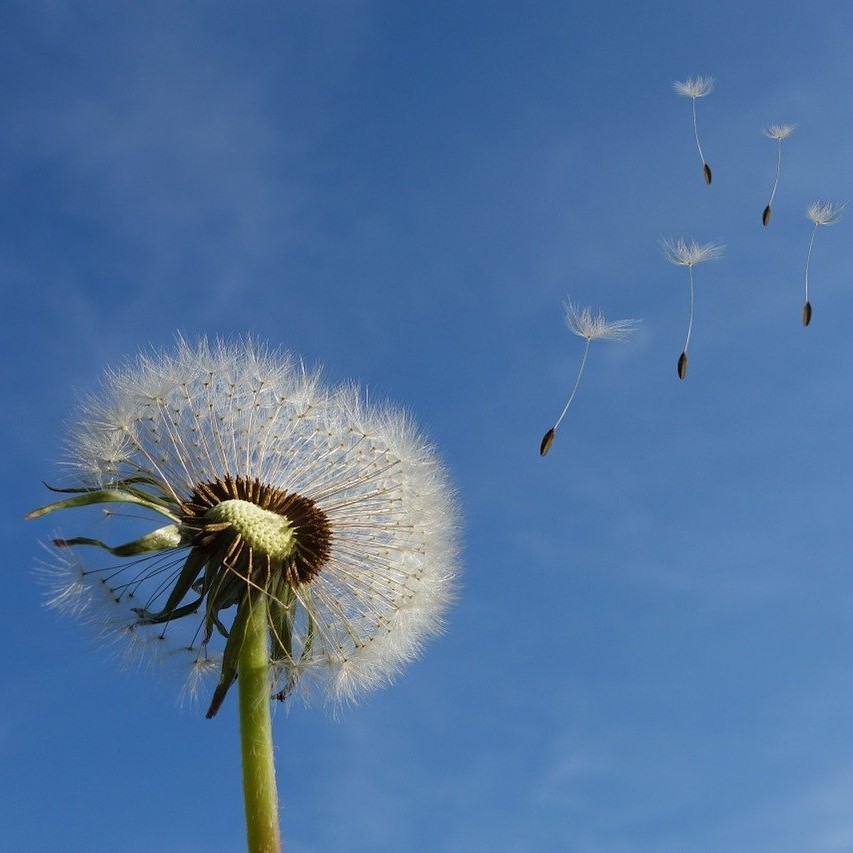
Dandelion seeds floating in the wind (Michael Schwarzenberger, Pixabay)

Dandelion seeds floating in the wind (Michael Schwarzenberger, Pixabay)
How does this align with my curriculum?
| Grade | Course | Topic |
|---|
Students will work collaboratively to design and build models of seeds that can travel as far as possible.
Overview
Students design and build models of seeds that use moving air to travel as far as possible.
Timing
60 minutes
Setting the Stage
Prior Skills and Knowledge
To successfully participate in this Design & Build, students should be able to use basic cutting tools and fasteners for construction. They should also have a basic understanding of the function of various parts of a plant, in particular the role of seeds. It is highly recommended that students conduct the Inquiry Seed Dispersal prior to doing this Design & Build challenge.
Context
The purpose of seeds is to bring the offspring of plants to new places when they can have space to grow. Many types of plants have specially adapted seeds that are able to travel away from the parent plant by making use of the wind. These wind-borne seeds are often capable of travelling large distances.
In this Design & Build challenge, students will work collaboratively to design and build models of seeds that use moving air to travel as far as possible.
This design and build could begin from:
- questions and/or comments that arise after showing students videos about how seeds travel.
- exploring photos of seeds as they move. Discuss using questions such as:
- “How do you think this type of seed moves? Why do you think so?”
- “Do all plants use the same method to move their seeds? Why do you think this is?”
- reading books such as Flip, Float, Fly: Seeds on the Move by JoAnn Early Macken, A Fruit is a Suitcase for Seeds, or Who Will Plant a Tree? Discuss using questions such as:
- “How did the seeds in this book get from place to place?”
- “Would the wind be a good way to move this type of seed? Why do you think this?”
- “What kinds of seeds do people eat? Does eating seeds help them move? Why do you think this?”

Design Criteria
As a class, students brainstorm criteria that their prototype seeds must meet. Educators may choose to add other criteria that are curriculum-specific, such as using joiners/fasteners, measuring, using specific materials, etc.
Design criteria examples:
- The seed must travel through the air as far as possible
- The seed cannot be thrown, only dropped
- The seed can only be moved using moving air
- Use only the materials provided
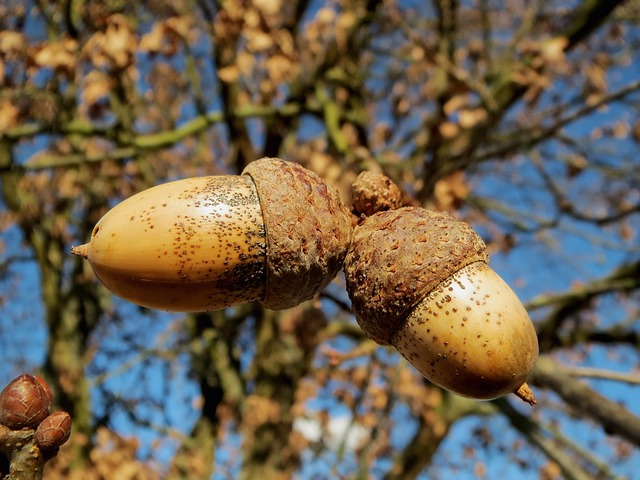
Details
- Pencils
- New or recycled craft materials such as construction paper, craft foam, tissue paper Styrofoam, aluminum foil, string, yarn, fabric, ribbon, pipe cleaners, craft sticks, buttons, etc.
- New or recycled containers such as paper plates, Styrofoam plates or bowls, etc.
- Construction tools such as scissors, rulers, tape, glue, etc.
- Measuring tools such as rulers, metre sticks, measuring tapes and/or stopwatch, etc.
- Recording tools such as pencils, erasers, paper, science notebooks, cameras, handheld electronic devices, etc.
- Table fan to provide moving air
- Collect an assortment of recycled and new materials that students will use to construct the prototype seeds. The materials list above is only a suggested list.
- Set up material sourcing stations, organized by type of material. Alternatively, organize an assortment of materials to be provided.
- Set up a station where the table fan will be.
Students develop Design & Build skills as they design, build and test a prototype seed that can move as far as possible using only moving air.
Students will follow the steps of the Design & Build process:
- identify the problem to be solved/need to be met
- brainstorm criteria that the prototype must meet
- share their questions and ideas for a solution to the problem/need
- discuss the pros and cons of each in order to select a potential solution to be tested
- visualize what the solution might look like and make design sketches based on their visualizations
- identify the tasks or key steps involved in developing the solution (the design plan)
- make decisions about tools and materials that will be needed
- build/develop the design idea based on their sketches and design plan
- test their prototypes based on the design criteria
- modify the prototype and retest it against the design criteria as necessary
- reflect on their results and identify things that could be done to improve their prototypes
Model Seed Testing Data Sheet [Google doc] [.pdf]
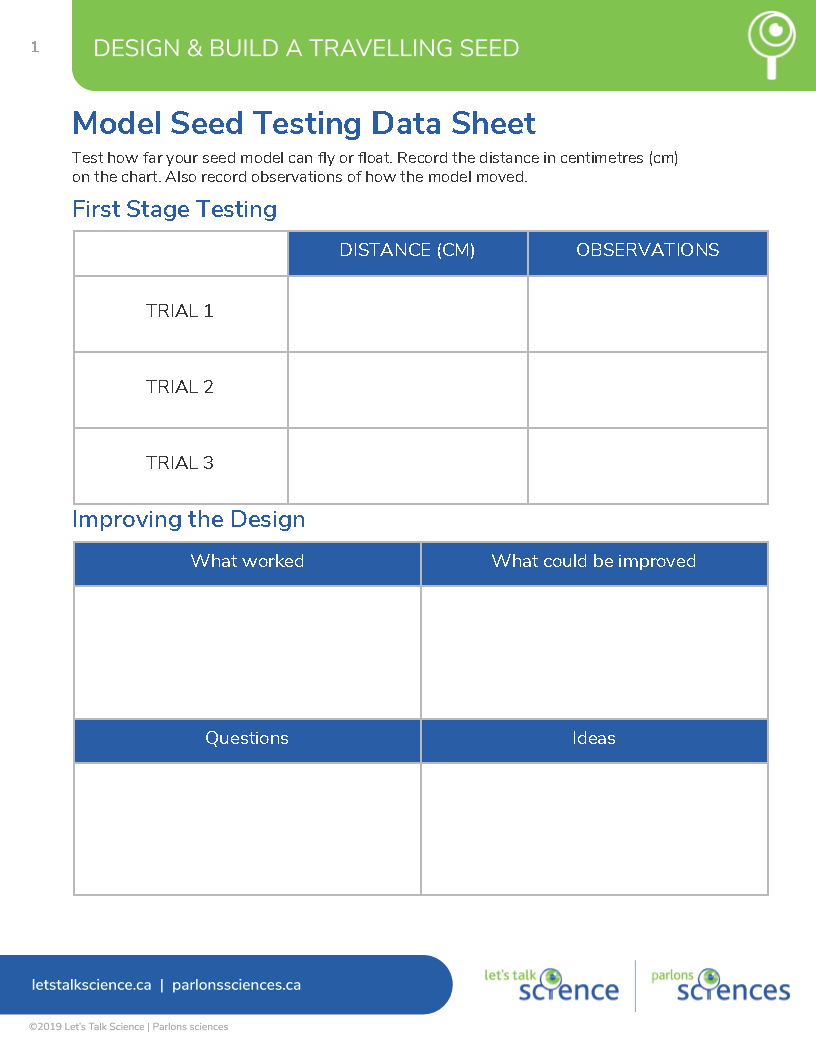
Observe and document, using anecdotal comments, photos and/or video recordings, students’ ability to:
- Work Collaboratively – students work collaboratively to complete a task and evaluate their group processes throughout the Design & Build process
- Generate Ideas – students use idea generation skills and strategies, such as brainstorming, to identify possible solutions as well as make decisions about the pros and cons of each solution
- Communicate – students communicate their thinking and learning in words, sketches, photos, videos, etc. (e.g., in identifying the problem, in design plans that include 2D design sketches and key design steps/tasks, in lists of materials/equipment/tools)
- Work Safely – students demonstrate safe practices when using a variety of tools and materials while prototyping
- Test – students use skills of observing and recording data as they test their prototypes
- Reflect – students reflect on the results of their prototype testing and suggest things that they might do differently to improve their prototypes
My Design Sketch Reproducible [Google doc] [.pdf]
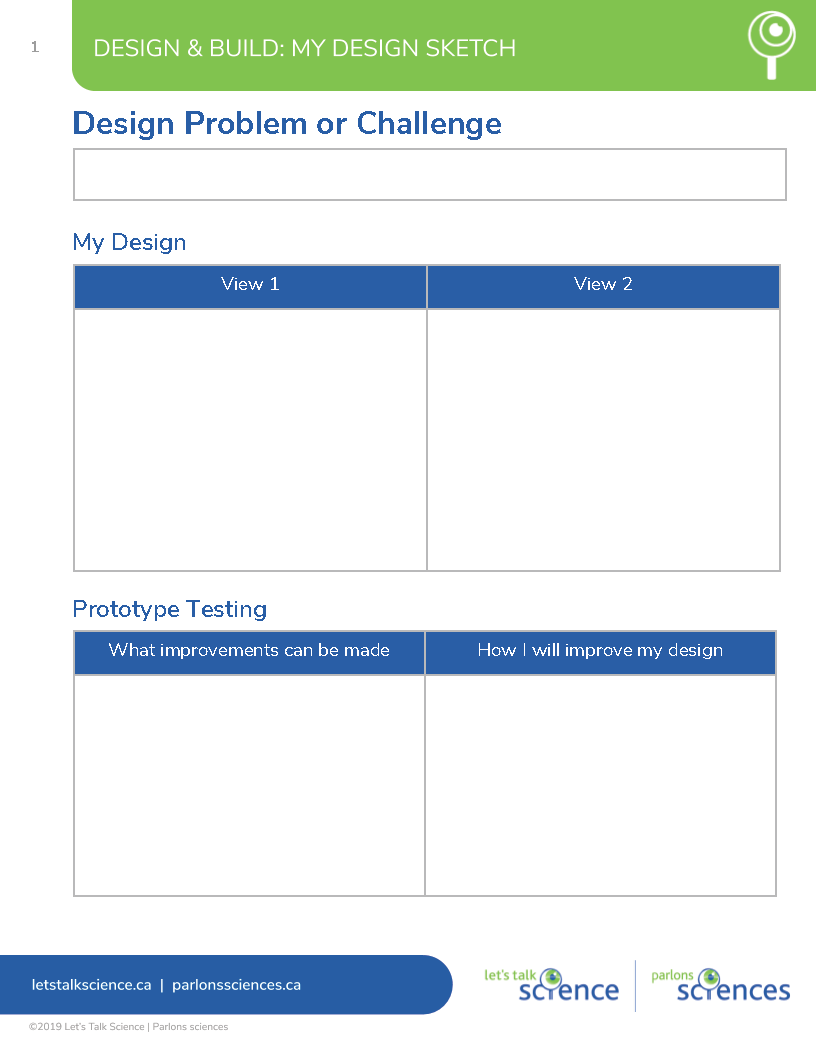
| Students: Saying, Doing, Representing |
Educator: Interactions: Responding, Challenging |
|---|---|
| Students identify and refine the problem to be solved/need to be met. |
|
| Students brainstorm and record criteria for the prototype seed. |
|
| Students visualize what the solution might look like and make design sketches based on their visualizations. |
|
| Students make observations and decisions about the available tools and materials. |
|
| Students build/develop and test the design idea based on their sketches and design plan (create the “prototype”). |
|
| Students modify the prototype and retest it against the design criteria as necessary. |
|
| Students reflect on the results of their testing and identify things that could be done differently in the future. |
|
Literacy
- Ask questions (e.g. “Why do seeds need to travel?”)
- Communicate thoughts, feelings and ideas (e.g. talk about ways in which seeds are transported and how humans may interfere with this)
- Brainstorm and work collaboratively to come up with many ways for their seed to be transported
Mathematical Thinking
- Take multiple tests/measurements of the distance the prototype travels before and after modifications and record these as data in a chart
- Calculate an average distance travelled by the seed model before and after modifications have been made
- Record other measurements based on the model and/or the performance of the models (e.g., mass, length and width, height of flight, time aloft, surface area)
- Perform data set analysis based on multiple tests of the model’s flight distance travelled (e.g., range, mean, median and mode)
- Compare all the models that the class has produced, then order the distance results of all the models the students create and display results in a chart
Visual Arts
- Sketch, represent, model their travelling seed prototypes
Examples for the classroom:- develop the design for the prototype in an online drawing program
- create a picture-based algorithm to code directions on how to build the final model
If your students are interested in learning more, the following may provoke their curiosity:
- Take the students outside and have them test their seed prototypes using real wind. How does this testing compare to using the fan?
- Have students try dropping the seed from a higher place, such as the top of playground equipment. How far do the seeds travel now?
- Students could repeat the Design & Build challenge, only this time create a seed that is transported by water.
- Students could repeat the Design & Build challenge, only this time create a seed that is transported by sticking onto clothing, like the seeds from a burdock plant.
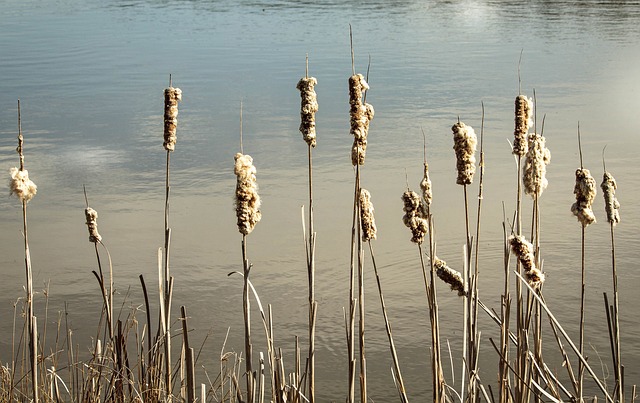
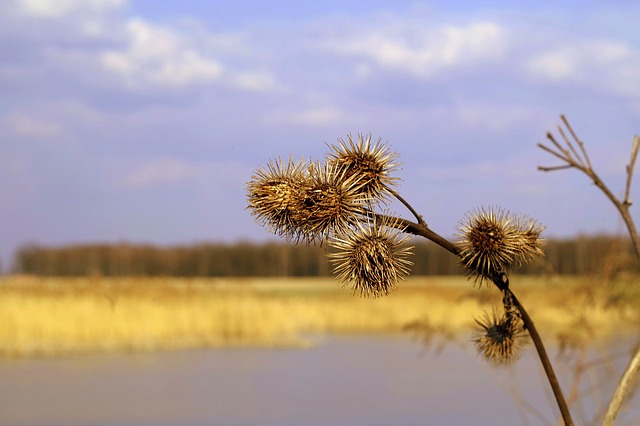
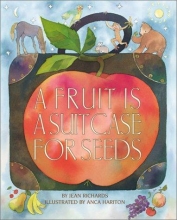
A Fruit is a Suitcase for Seeds
by Jean Richards
Learn how fruits are designed to protect a plant's seeds and help to spread a plant's seeds to new places.
ISBN: 9780822559917
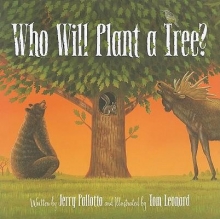
Who Will Plant a Tree?
by Jerry Pallotta
Learn how many different kinds of animals, from ants to dolphins, help plants to disperse their seeds.
ISBN: 9781585365029
Videos
How do seeds travel? (2012) Asaucebu -- Animated video (2:59 min.) for young children about seed dispersal.
Seed Dispersal (STEM bite) (2012) StemBite -- In this video (2:36 min.), Andrew Vanden Heuvel explores the many interesting ways that seeds are distributed far and wide.
Exploding Seeds (2016) Smithsonian Channel -- This video (1:53 min.) has extreme closeups of seeds being dispersed by expulsion.
The Sneaky Reason Why Plants Bear Fleshy Fruit (2015) Smithsonian Channel -- Many plants rely on the wind to transport their seeds. However, in thick forests this system proved difficult. How did plants solve the problem? Find out in this video (1:35 min.).
Images
Plants: Seeds (Picture Collections)
6 images of some seeds which are the fertilized part of a plant used for germinating new plants such as fennel, kiwis and pumpkins
Plant Reproduction (Backgrounder)
Learn about sexual and asexual reproduction in plants
Plant Life Cycle (Lessons)
Students develop and apply the skills of observing, comparing & contrasting, and communicating as they explore life cycles of familiar plants.
Design & Build a Seed Saver (Lessons)
Students will work collaboratively to design and build a structure that will protect a seed from the elements.
Design & Build a Seed Sorter (Lessons)
Students work collaboratively to design and build a device that is able to sort seeds by size.
Materials
- Pencils
- New or recycled craft materials such as construction paper, craft foam, tissue paper Styrofoam, aluminum foil, string, yarn, fabric, ribbon, pipe cleaners, craft sticks, buttons, etc.
- New or recycled containers such as paper plates, Styrofoam plates or bowls, etc.
- Construction tools such as scissors, rulers, tape, glue, etc.
- Measuring tools such as rulers, metre sticks, measuring tapes and/or stopwatch, etc.
- Recording tools such as pencils, erasers, paper, science notebooks, cameras, handheld electronic devices, etc.
- Table fan to provide moving air
Preparation
- Collect an assortment of recycled and new materials that students will use to construct the prototype seeds. The materials list above is only a suggested list.
- Set up material sourcing stations, organized by type of material. Alternatively, organize an assortment of materials to be provided.
- Set up a station where the table fan will be.
What to Do
Students develop Design & Build skills as they design, build and test a prototype seed that can move as far as possible using only moving air.
Students will follow the steps of the Design & Build process:
- identify the problem to be solved/need to be met
- brainstorm criteria that the prototype must meet
- share their questions and ideas for a solution to the problem/need
- discuss the pros and cons of each in order to select a potential solution to be tested
- visualize what the solution might look like and make design sketches based on their visualizations
- identify the tasks or key steps involved in developing the solution (the design plan)
- make decisions about tools and materials that will be needed
- build/develop the design idea based on their sketches and design plan
- test their prototypes based on the design criteria
- modify the prototype and retest it against the design criteria as necessary
- reflect on their results and identify things that could be done to improve their prototypes
Model Seed Testing Data Sheet [Google doc] [.pdf]

Assessment
Observe and document, using anecdotal comments, photos and/or video recordings, students’ ability to:
- Work Collaboratively – students work collaboratively to complete a task and evaluate their group processes throughout the Design & Build process
- Generate Ideas – students use idea generation skills and strategies, such as brainstorming, to identify possible solutions as well as make decisions about the pros and cons of each solution
- Communicate – students communicate their thinking and learning in words, sketches, photos, videos, etc. (e.g., in identifying the problem, in design plans that include 2D design sketches and key design steps/tasks, in lists of materials/equipment/tools)
- Work Safely – students demonstrate safe practices when using a variety of tools and materials while prototyping
- Test – students use skills of observing and recording data as they test their prototypes
- Reflect – students reflect on the results of their prototype testing and suggest things that they might do differently to improve their prototypes
My Design Sketch Reproducible [Google doc] [.pdf]

Co-constructed Learning
| Students: Saying, Doing, Representing |
Educator: Interactions: Responding, Challenging |
|---|---|
| Students identify and refine the problem to be solved/need to be met. |
|
| Students brainstorm and record criteria for the prototype seed. |
|
| Students visualize what the solution might look like and make design sketches based on their visualizations. |
|
| Students make observations and decisions about the available tools and materials. |
|
| Students build/develop and test the design idea based on their sketches and design plan (create the “prototype”). |
|
| Students modify the prototype and retest it against the design criteria as necessary. |
|
| Students reflect on the results of their testing and identify things that could be done differently in the future. |
|
Cross-curricular Connections
Literacy
- Ask questions (e.g. “Why do seeds need to travel?”)
- Communicate thoughts, feelings and ideas (e.g. talk about ways in which seeds are transported and how humans may interfere with this)
- Brainstorm and work collaboratively to come up with many ways for their seed to be transported
Mathematical Thinking
- Take multiple tests/measurements of the distance the prototype travels before and after modifications and record these as data in a chart
- Calculate an average distance travelled by the seed model before and after modifications have been made
- Record other measurements based on the model and/or the performance of the models (e.g., mass, length and width, height of flight, time aloft, surface area)
- Perform data set analysis based on multiple tests of the model’s flight distance travelled (e.g., range, mean, median and mode)
- Compare all the models that the class has produced, then order the distance results of all the models the students create and display results in a chart
Visual Arts
- Sketch, represent, model their travelling seed prototypes
Examples for the classroom:- develop the design for the prototype in an online drawing program
- create a picture-based algorithm to code directions on how to build the final model
Extending the Learning
If your students are interested in learning more, the following may provoke their curiosity:
- Take the students outside and have them test their seed prototypes using real wind. How does this testing compare to using the fan?
- Have students try dropping the seed from a higher place, such as the top of playground equipment. How far do the seeds travel now?
- Students could repeat the Design & Build challenge, only this time create a seed that is transported by water.
- Students could repeat the Design & Build challenge, only this time create a seed that is transported by sticking onto clothing, like the seeds from a burdock plant.


Supporting Media

A Fruit is a Suitcase for Seeds
by Jean Richards
Learn how fruits are designed to protect a plant's seeds and help to spread a plant's seeds to new places.
ISBN: 9780822559917

Who Will Plant a Tree?
by Jerry Pallotta
Learn how many different kinds of animals, from ants to dolphins, help plants to disperse their seeds.
ISBN: 9781585365029
Videos
How do seeds travel? (2012) Asaucebu -- Animated video (2:59 min.) for young children about seed dispersal.
Seed Dispersal (STEM bite) (2012) StemBite -- In this video (2:36 min.), Andrew Vanden Heuvel explores the many interesting ways that seeds are distributed far and wide.
Exploding Seeds (2016) Smithsonian Channel -- This video (1:53 min.) has extreme closeups of seeds being dispersed by expulsion.
The Sneaky Reason Why Plants Bear Fleshy Fruit (2015) Smithsonian Channel -- Many plants rely on the wind to transport their seeds. However, in thick forests this system proved difficult. How did plants solve the problem? Find out in this video (1:35 min.).
Images
Plants: Seeds (Picture Collections)
6 images of some seeds which are the fertilized part of a plant used for germinating new plants such as fennel, kiwis and pumpkins
Learn More
Plant Reproduction (Backgrounder)
Learn about sexual and asexual reproduction in plants
Plant Life Cycle (Lessons)
Students develop and apply the skills of observing, comparing & contrasting, and communicating as they explore life cycles of familiar plants.
Design & Build a Seed Saver (Lessons)
Students will work collaboratively to design and build a structure that will protect a seed from the elements.
Design & Build a Seed Sorter (Lessons)
Students work collaboratively to design and build a device that is able to sort seeds by size.
